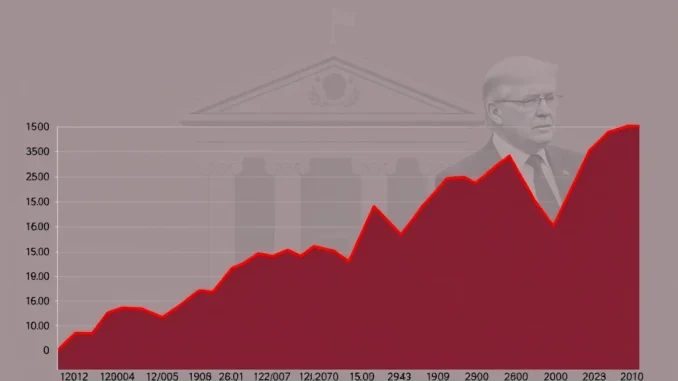
Are you feeling the tremors in the crypto market? Recent statements from Federal Reserve Chair Jerome Powell are sending ripples across the financial world, and cryptocurrency investors are paying close attention. Powell has just indicated that the Federal Reserve is nowhere near finished with its balance sheet reduction. What does this mean for your crypto portfolio and the broader digital asset landscape? Let’s dive into the details and uncover the potential implications.
Decoding Powell’s Balance Sheet Remarks
Jerome Powell’s recent announcement, as reported by CLS News, explicitly stated that the Federal Reserve is not contemplating an end to its Fed balance sheet reduction strategy. He emphasized that reserves within the financial system remain ample, suggesting there’s still a considerable way to go before the Fed considers easing up. This statement, while seemingly technical, carries significant weight for all markets, especially the volatile cryptocurrency sector. But what exactly is balance sheet reduction, and why should crypto enthusiasts care?
What is Fed Balance Sheet Reduction?
In simple terms, the Federal Reserve’s balance sheet is a record of its assets and liabilities. During times of economic crisis, like the 2008 financial meltdown or the more recent pandemic, the Fed often expands its balance sheet by purchasing assets, primarily government bonds and mortgage-backed securities. This is a tool known as quantitative easing (QE), designed to inject liquidity into the market and lower long-term interest rates.
However, to combat inflation, the Fed reverses this process – balance sheet reduction, also known as quantitative tightening (QT). This involves either selling assets or simply allowing them to mature without reinvesting the proceeds. The effect is to drain liquidity from the market, which can have several consequences:
- Increased Borrowing Costs: As liquidity decreases, borrowing becomes more expensive for businesses and individuals.
- Potential Slowdown in Economic Activity: Higher borrowing costs can curb investment and spending, potentially slowing down economic growth.
- Impact on Asset Prices: Reduced liquidity can lead to a decrease in asset prices, including stocks, bonds, and yes, cryptocurrencies.
So, when Powell says the Fed isn’t close to ending balance sheet reduction, he’s essentially signaling that the tightening of monetary policy will persist. This is crucial context for understanding the potential headwinds facing the crypto market.
Why Powell’s Balance Sheet Stance Matters for Crypto Reserves
Cryptocurrencies, often viewed as risk-on assets, are particularly sensitive to changes in monetary policy. When liquidity is abundant and interest rates are low, investors are more inclined to venture into higher-risk, higher-reward assets like Bitcoin and Ethereum. Conversely, when liquidity dries up and borrowing costs rise, investors tend to become more risk-averse, often shifting towards safer havens.
Powell’s statement about continuing Powell balance sheet reduction implies that the environment of tighter liquidity is set to continue. This can directly impact crypto reserves and market dynamics in several ways:
- Reduced Investment Flow: As overall market liquidity decreases, the flow of funds into crypto assets might slow down. Institutional investors and even retail traders may become more cautious, reducing their exposure to cryptocurrencies.
- Increased Volatility: Periods of monetary tightening are often associated with increased market volatility. The crypto market, already known for its price swings, could experience even greater turbulence as investors react to the changing liquidity landscape.
- Pressure on Crypto Lending and DeFi: The decentralized finance (DeFi) sector relies heavily on liquidity. A tighter liquidity environment could put pressure on DeFi protocols and crypto lending platforms, potentially leading to higher borrowing rates and increased risk.
Dollar Liquidity and its Global Implications for Crypto
Powell also reaffirmed the Fed’s readiness to provide dollar liquidity overseas if needed. This is a critical aspect, especially in today’s interconnected global financial system. The demand for dollars often surges during times of economic stress, and the Fed acts as a lender of last resort to ensure global financial stability.
How does this relate to crypto? The global nature of the cryptocurrency market means it’s influenced by international dollar flows. If there’s a global dollar shortage, it can impact crypto markets in various ways:
| Scenario | Potential Crypto Market Impact |
|---|---|
| Dollar Shortage Increases | Investors may liquidate crypto holdings to obtain dollars, leading to sell-offs. |
| Fed Provides Dollar Liquidity | Could ease pressure on markets, potentially stabilizing crypto prices, but the underlying trend of balance sheet reduction remains. |
| Emerging Market Stress | Dollar strength due to tight policy can hurt emerging markets, indirectly affecting global crypto sentiment and investment. |
Powell’s assurance of providing dollar liquidity is a safety valve, but it doesn’t negate the overall direction of monetary policy tightening. It’s more of a measure to prevent systemic crises rather than a signal of easing up on balance sheet reduction.
Navigating the Crypto Market in a Tightening Monetary Policy Era
So, what actionable insights can crypto investors glean from Powell’s statements? Here are a few key takeaways:
- Expect Continued Volatility: The era of easy money is receding. Prepare for ongoing volatility in the crypto market as the Fed continues its balance sheet reduction and maintains a hawkish stance on inflation.
- Focus on Risk Management: Now more than ever, robust risk management is crucial. Diversify your portfolio, manage your position sizes, and avoid excessive leverage.
- Stay Informed: Keep a close watch on macroeconomic indicators, Fed announcements, and global financial developments. These factors will increasingly influence crypto market movements.
- Long-Term Perspective: Remember that market cycles are inherent. While the current environment may present challenges, it also offers opportunities for long-term investors who can weather short-term turbulence and focus on fundamentally strong crypto projects.
Conclusion: A New Landscape for Crypto?
Jerome Powell’s recent remarks serve as a clear signal: the Federal Reserve is committed to tackling inflation, and balance sheet reduction is a key tool in their arsenal. For the cryptocurrency market, this means navigating a landscape characterized by tighter liquidity and potentially increased volatility. While the Fed’s readiness to provide dollar liquidity offers some reassurance against systemic shocks, the overarching trend points towards continued pressure on risk assets, including crypto.
The key for crypto investors is to adapt, remain vigilant, and focus on long-term value amidst the short-term noise. Understanding the implications of Fed balance sheet policy is no longer optional – it’s essential for navigating the evolving crypto market in the months and years ahead. Are you prepared for the journey?



